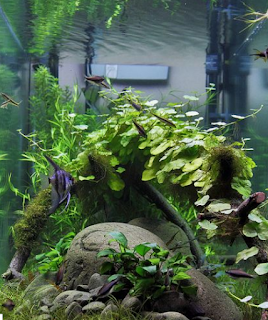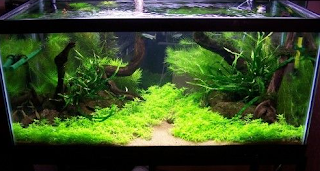Sunday, 28 February 2016
Sunday, 21 February 2016
Basics of a Planted Aquarium step by step
Planted aquariums are living works of art. Plants remove nitrates and phosphates, helping to improve water quality between water changes in an aquarium. Planted aquariums are easy to set up or keep.
This is a basic installation outline, to help beginners succeed with there first attempt. In this order, article will cover:
- tank selection
- substrate
- water
- thermometer
- filters
- bacteria
- heaters
- light
- aeration
- planting
- hard-scape
- planting
- carbon dioxide
- fertilizer
- fishes
Tank
How to set up a planted tank begins with the tank itself. Tanks come in many shapes and sizes. The most common shape is the rectangular cube. Ideally for beginner length * breadth * Height of fish tank should be 2 feet * 1 foot* 1 foot respectively.
Substrate
Substrate is important. . A mixture of rocks, sand, smooth gravel, and aquarium planting medium will give the best results.
First rinse the substrates before adding them to your tank. The water should run clean.
Aquarium planting medium is usually clay beads, not always a desirable appearance. It holds nutrients for slow release directly to the roots, with preference to extensively rooting plants.
Add the rocks into the tank, creating barriers to hold the other substrates in a slope.
Plan to plant, plants with large root structures in deep substrate, because they gather more nutrients from the substrate; instead of the water itself.
Next add the smooth gravel making it level with the top of the rock retaining walls; some will leak through the cracks, that’s OK. The gavel goes under the sand helping the retaining walls to be more effective. As time goes on more gravel will mix with the sand on the surface.
Finally add sand.
Thermometer
A thermometer is a critical piece of equipment. A thermometer will tell you when your heater is not working correctly, or when the water gets too hot from a hot day. One that floats or is suction cupped to the inside of the tank is preferred. The tape like, stick on the side, type is less accurate and can’t be removed to test water before it is added.
Water
All water is not the same. Tap water is what most people use for their aquarium. It must be treated. There are a few different methods of treatment: deionizing, sitting, and chemical detoxification.
pH
pH is the most important. Pure H2O has a pH of 7.2. A pH of 7 is considered neutral. Aquarium water should not very more than .2 between weekly water changes.
Filter
Install the filter and begin cycling the tank. There are many types of filters. Canisters are the best but HOBs are the most common. If you have under-gravel filter replace it. Fillers are rated by how fast they pump water, not how much filter media they have. instead of filter media, filter quality is extremely variable.
Bacteria
Add a bacteria culture to jump start the nitrogen cycle. There are two types of bacteria that need to be added; one to covert ammonia into nitrite, and another to convert nitrite into nitrate. Fish should not be added until the bacteria have successfully colonized. This will happen in about a week.
A filters main purpose is not to remove anything from the water; instead it provides a place for these beneficial bacteria to flourish. The bacteria will break down ammonia into nitrite then into nitrate. Ammonia is extremely toxic to your plants and animals, nitrite is less toxic to your animals, and nitrate is the least.
When you’re doing your weekly water changes, you are lowering the nitrate levels by diluting the old water with new water. Plants in your tank will feed on the nitrate and this includes algae. The nitrate levels should be kept beneath 2 parts per million, higher levels are acceptable but more algae will grow.
Having plants in your fish tank will not alter the need for weekly water changes, but they will improve water quality between changes.
Heaters
Light
Next add light. For best results use heavy light, these fixtures are available for coral aquariums. The spectrum of light that you use is also an important factor. Plants mainly use a color of light that is not produced in most bulbs. It is very advisable to use a timer for the lights so that a regular day/night cycle can be established.
Types of Fixtures
LED fixtures are the best for most aquariums. LED fixtures with enough light output are expensive.
Aeration
Plants need oxygen at night when the lights are off. They absorb oxygen though their roots. Plants release oxygen through their roots during the day and absorb it at night. Aeration isn't necessary for aquatic plant growth but will promote it. The aeration will help maintain the health of fish and invertebrates by supplementing the filter and plants.
Use an aeration pump that is over rated for you aquarium.
Aquascape
Now add your aquascape. aquascape consists of wood, large rocks, aquatic plants and large pieces of décor. Most professional planted aquarium designers use natural looking aquascape. Using things that are obviously man made breaks the illusion of a fish world. For best results use real rocks, and real bog or root wood.
Collecting drift and root wood from outside is tricky. It’s best to buy your wood from pet stores then soak and boil it for a few days.
Planting
Plants should be placed with the tallest in the back and the shortest in the front. As a secondary consideration place the ones with more finely detailed leaves in front of the ones with more uniform patterns. Plants with large roots go in the deepest substrate. Plants with smaller roots can be planted in the rocks, crevices, and shallow substrate.
A few easy first plants are: Horn Wort, Amazon Sword, Jungle Vale, Java Moss, Water Sprite, Java Fern, Water Lilies, and Anubias species.
Fishes
Wait about a week before adding any animals. This allows the bacteria culture to develop inside the filter and the substrate. fish need room to swim. Instead of trying to house as many fish as possible, try to provide the best environment for a few fish. This will help with algae by reducing the amount of waste in the water.
A group of smaller fish looks better than a couple big fish,
Ideally you want fish that swim at the top and middle areas, with a bottom feeder or two. Overcrowding increases stress and aggressive behavior.
Shrimp are most comfortable if they have moss. They will eat, sleep, breed, and hide in the moss.
also see the compatibility of fish with other fishes.
source hubpages
If you liked post, please like facebook page to get new updates on similar topics
https://www.facebook.com/aquariumvilla.aquariumservicesinm…/
https://www.facebook.com/aquariumvilla.aquariumservicesinm…/
Saturday, 20 February 2016
with some beautifully shaped driftwood and aquarium plants, you must try this aquascape in your fish tank
source pinterest
If you liked post, please like facebook page to get new updates on similar topics
https://www.facebook.com/aquariumvilla.aquariumservicesinm…/
https://www.facebook.com/aquariumvilla.aquariumservicesinm…/
easy and beautyfull aquascape with aquarium plants,
source pinterest
source pinterest
If you liked post, please like facebook page to get new updates on similar topics
https://www.facebook.com/aquariumvilla.aquariumservicesinm…/
https://www.facebook.com/aquariumvilla.aquariumservicesinm…/
Wednesday, 17 February 2016
How to make a planted aquarium at home
- First you have to decide the size of the tank to set up a planted aquarium. For example: 3 x 1.5 x 1.5 feet.
- For a planted tank, lightning is more important. The calculation for this is 3-4 watts per gallon. For the tank size above mentioned, we need four 2-feet Phillips CFL lights.
- At first keep the peat cakes and spread the fe-humus substrate and then spread the Laterite soil substrate. The layer should be 3 inches of thickness.
- Make the substrate wet by just adding 2-3 liters of water.
- Set the internal filter or external filter (top filter is preferred).
- Fill the tank with plants and aquarium driftwood.
- Now add 1/2 of water and switch on the filter system.
- Switch on the lights.
- After 4 days increase the water level to top.
- Start giving Co2 (carbon dioxide) after day 10.
- The tank gets matured after 20 days.
- Now u can add fishes.
Source hubpages.com
Subscribe to:
Comments (Atom)














